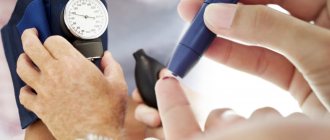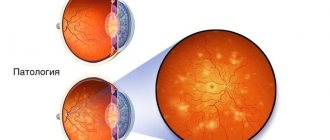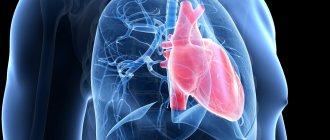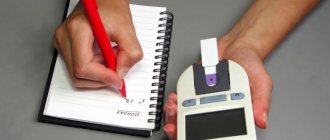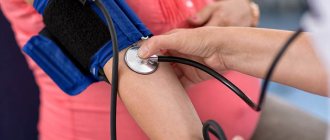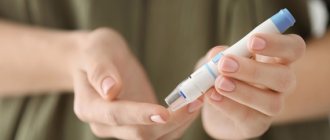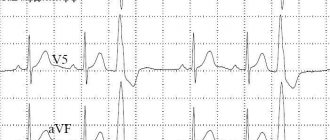Diabetes mellitus type 2 - symptoms and treatment
Treatment of type II diabetes involves solving the main problems:
- compensate for the lack of insulin;
- correct hormonal and metabolic disorders;
- implementation of therapy and prevention of complications.
To solve them, the following treatment methods are used:
- diet therapy;
- physical exercise;
- use of glucose-lowering drugs;
- insulin therapy;
- surgical intervention.
Diet therapy
The diet for type II diabetes, like a regular diet, requires an optimal ratio of the main substances contained in foods: proteins should make up 16% of the daily diet, fats - 24%, and carbohydrates - 60%. The difference between the diet for type II diabetes lies in the nature of the carbohydrates consumed: refined sugars are replaced by slowly digestible carbohydrates. Since this disease occurs in obese people, weight loss is the most important condition for normalizing blood glucose levels. In this regard, a caloric diet is recommended, in which the patient will lose 500 g of body weight weekly until reaching the ideal weight. However, weekly weight loss should not exceed 2 kg, otherwise this will lead to excessive loss of muscle rather than fat tissue. The number of calories required for the daily diet of patients with type II diabetes is calculated as follows: women need to multiply their ideal weight by 20 kcal, and men by 25 kcal.
When following a diet, it is necessary to take vitamins, since during diet therapy they are excessively excreted in the urine. The lack of vitamins in the body can be compensated by rational consumption of healthy foods, such as fresh herbs, vegetables, fruits and berries. During the winter and spring periods, it is possible to take vitamins in yeast form.
Exercise stress
A correctly selected system of physical exercises, taking into account the course of the disease, age and present complications, contributes to a significant improvement in the condition of the patient with diabetes. This treatment method is good because the need to use insulitis practically disappears, since during physical activity glucose and lipids are burned without its participation.
Treatment with glucose-lowering drugs
Today, derivatives of glucose-lowering drugs are used:
- sulfonylureas (tolbutamide, glibenclamide);
- biguanides, which reduce gluconeogenesis in the liver and increase the sensitivity of muscles and liver to insulin (metformin);
- thiazolidinediones (glitazones), similar in properties to biguanides (pioglitazone, rosiglitazone);
- alpha-glucosidase inhibitors, which reduce the rate of glucose absorption in the gastrointestinal tract (acarbose);
- agonists of glucagon-like peptide-1 receptors, stimulating the synthesis and secretion of insulin, reducing liver glucose production, appetite and body weight, slowing down the evacuation of the food bolus from the stomach (exenatide, liraglutide);
- depeptidyl peptidase-4 inhibitors, which also stimulate the synthesis and secretion of insulin, reduce the production of glucose by the liver, do not affect the rate of evacuation of food from the stomach and have a neutral effect on body weight (sitagliptin, vildagliptin);
- inhibitors of sodium-glucose cotransporter type 2 (gliflozin), which reduce the reabsorption (absorption) of glucose in the kidneys, as well as body weight (dapagliflozin, empagliflozin).
Insulin therapy
Depending on the severity of the disease and the complications that arise, the doctor prescribes insulin. This treatment method is indicated in approximately 15-20% of cases. Indications for the use of insulin therapy are:
- rapid weight loss for no apparent reason;
- the occurrence of complications;
- insufficient effectiveness of other glucose-lowering drugs.
Surgery
Despite the many hypoglycemic drugs, the question of their correct dosage, as well as patient adherence to the chosen method of therapy, remains unresolved. This, in turn, creates difficulties in achieving long-term remission of type II diabetes. Therefore, surgical therapy for this disease—bariatric or metabolic surgery—is becoming increasingly popular around the world. The IFD considers this method of treating patients with type II diabetes to be effective. Currently, more than 500,000 bariatric surgeries are performed worldwide each year. There are several types of metabolic surgery, the most common being gastric bypass and mini gastric bypass.[4]
Roux-en-Y gastric bypass
During bypass surgery, the stomach is divided below the esophagus so that its volume is reduced to 30 ml. The remaining large part of the stomach is not removed, but is sealed, preventing food from entering it.[5] As a result of the intersection, a small stomach is formed, to which the small intestine is then sewn, 1 m away from its end. This way, food will go directly into the large intestine, while its processing by digestive juices will be reduced. This, in turn, provokes irritation of L-cells in the ileum, which contributes to a decrease in appetite and an increase in the growth of cells that synthesize insulin.
Mini gastric bypass
The main difference between mini-gastrobypass and classic gastric bypass is the reduction in the number of anastomoses (connections of intestinal segments).[2] When performing a traditional operation, two anastomoses are performed: the connection of the stomach and small intestine and the connection of different parts of the small intestine. With mini-gastrobypass, there is only one anastomosis - between the stomach and the small intestine. Due to the small volume of the newly formed stomach and the rapid entry of food into the small intestine, the patient has a feeling of fullness even after eating small portions of food.
Other types of bariatric surgery include:
- gastropplication - suturing the stomach to prevent it from stretching;[8]
- sleeve gastroplasty (otherwise called laparoscopic longitudinal gastrectomy) - cutting off most of the stomach and forming a 30 ml gastric tube, which promotes rapid saturation and also allows you to avoid following a strict diet;
- Gastric banding is a reduction in the volume of the stomach using a special ring (band) placed on the upper part of the stomach (this intervention is reversible).
Contraindications to surgical treatment are the presence of esophagitis (inflammation of the mucous membrane of the esophagus), varicose veins of the esophagus, portal hypertension, liver cirrhosis, gastric or duodenal ulcer, chronic pancreatitis, pregnancy, alcoholism, severe diseases of the cardiovascular system or mental illness. disorders, as well as long-term use of hormonal drugs.
Not by diet alone
Doctors also prescribe a diet for type 2 diabetes, which is very good. But there is also a certain imbalance here: between the psychology of the doctor and the psychology of the patient. The doctor thinks: the person came to me for treatment, so I will prescribe him medications and a diet so that he does not eat carbohydrates and sweets (he will advise adding fat to his diet). Based on this, the doctor prescribes Metformin and diet.
The patient thinks differently: he comes to the doctor, who prescribes medication and recommends dieting, walking more, and maintaining a sleep-wake schedule. Patients have heard about the pills, and information about maintaining a proper diet and life is not relevant for them. After the appointment, the person goes to the pharmacy, purchases medications and is satisfied that the first point of medical prescription has been completed. The patient is confident that he will follow other medical recommendations. Then I took the pill, and everything else will happen tomorrow: diet, sleep and wakefulness, as well as walks in the fresh air. Important: most patients do not realize that treating diabetes without medications is possible, and it is so important to lead a healthy lifestyle and adhere to the diet prescribed by the doctor.
When to see a doctor
An endocrinologist deals with the diagnosis and treatment of type 1 and type 2 diabetes mellitus. At JSC "Medicine" (clinic of academician Roitberg), which is located at 2nd Tverskoy-Yamskaya per. 10, you can find first-class specialists. As soon as the first signs of diabetes mellitus appear in women or men, it is necessary to go to the hospital.
Symptoms of diabetes mellitus in men and women are usually expressed in strong and frequent thirst, frequent urination (especially at night), sudden weight loss, and increased appetite.
Causes
Genetic predisposition to type 2 diabetes plays a big role. Therefore, if one of your relatives suffered from this pathology: you should eat properly (exclude sweets from the diet), lead an active lifestyle, and also undergo regular examinations. Experts identify the following causes of the disease:
- constant stress;
- sedentary lifestyle;
- bad ecology;
- fast food (the diet should contain large quantities of vegetables and fruits);
- excess body weight;
- age (as patients age, insulin resistance decreases);
- gestational diabetes in the past;
- high pressure;
- taking certain medications (especially without a doctor’s prescription);
- history of strokes and/or heart attacks;
- ethnicity;
- lack of physical activity;
- unhealthy diet (including consumption of drinks containing high sugar content).
Endocrinologists focus on the fact that in the last few years the number of patients who have been diagnosed with type 2 diabetes has increased several times. The reason for this is banal: non-compliance with simple but effective rules.
What to do?
It is important to know that diabetes, like many other diseases, is easier to prevent than to treat. To prevent the development of diabetes, it is necessary to undergo regular examination, especially if there are risk factors (such as excess weight, age over 40 years, metabolic disorders, atherosclerosis, hypertension, high cholesterol, sedentary lifestyle, etc.). The most important indicator for diagnosing diabetes is glycated hemoglobin (HbA1c), which reflects the average blood glucose level over three months. The level of glycated hemoglobin should normally be less than 6.1%. To undergo a complete examination to diagnose diabetes, you must consult a specialist.
Signs
With type 2 diabetes mellitus, the following symptoms develop:
- cramps in the calves;
- constant weakness;
- frequent urination;
- decreased vision (sugar accumulates in the blood, which leads to swelling of the lens);
- itching of the skin, dry skin, and pustular infections;
- a constant feeling of thirst (it does not stop with the consumption of liquid, some patients drink 5 liters of liquid per day);
- insomnia;
- protracted infectious pathologies;
- dizziness;
- reduced performance;
- increased appetite;
- increased fatigue;
- muscle weakness;
- foot pain;
- irritability;
- itching in the genital area;
- a drop in body temperature below average;
- decreased potency, sexual activity;
- obesity or rapid weight loss;
- wounds that do not heal over a long period of time.
I would like to draw your attention to the fact that very often type 2 diabetes mellitus is asymptomatic. To prevent this, you should adhere to a healthy lifestyle and do not forget about regular medical examinations (this should be done once a year).
If you are concerned about at least one of the symptoms described above, you should immediately contact an experienced endocrinologist. It is no secret that most doctors prescribe medications, but type 2 diabetes is easy to cure without medications. The doctor is obliged to inform about the need for a correct and active lifestyle, and tell the patient about what diet to follow.
